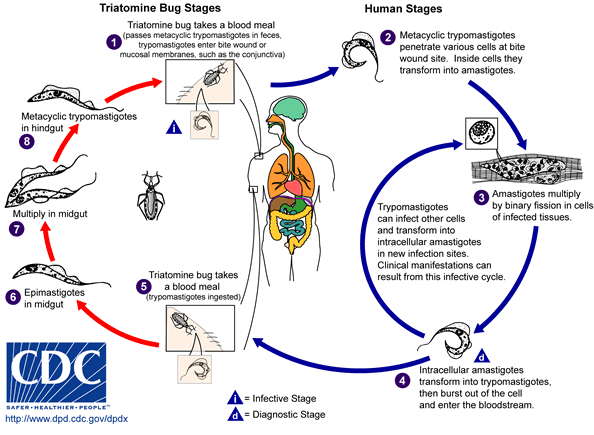Chagas disease causes
|
Chagas disease Microchapters |
|
Diagnosis |
|---|
|
Treatment |
|
Case Studies |
|
Chagas disease causes On the Web |
|
American Roentgen Ray Society Images of Chagas disease causes |
Editor-In-Chief: C. Michael Gibson, M.S., M.D. [1]; Associate Editor(s)-in-Chief: Yazan Daaboul, M.D.
Overview
Chagas disease (American tryponosomiasis) is a human tropical parasitic disease usually caused by Trypanosoma cruzi, a flagellate protozoa.
Causes
Etiologic Agent
- Chagas disease (American trypanosomiasis) is a human tropical parasitic disease usually caused by Trypanosoma cruzi, a flagellate protozoa.
Transmission
- Chagas disease usually has a vector-borne transmission. Triatomine insects, the Riduvid (kissing/assassin) bugs, suck blood from an infected individual and are subsequently infected themselves.
- The insects carry the pathogen in their feces and urine. Human infection with T. cruzi occurs following exposure to feces/urine of infected insects. The pathogen typically enters the host either through a wound induced by the host's scratching following the insect bite or through the conjunctival mucus membranes.
- Triatomine insects may also be referred to as benchuca, vinchuca, kissing bug, chipo, chupança and barbeiro. Other insect species that may be vectors for T. cruzi are insects of the families Rhodnius and Panstrongylus
- Other modes of transmission include organ transplantation, blood transfusions, vertical transmission, breast milk, and oral transmission following ingestion of infected foods.[1][2][3][4]
Life Cycle
The following figure illustrates the life cycle of T. cruzi, the causative pathogen of Chagas disease.

Gallery
-
Triatoma infestans or the “Kissing Bug”, “Assassin Bug”, or “Cone-Nose Bug”, is a vector for Chagas' Disease. From Public Health Image Library (PHIL). [5]
-
Dorsal view of the “kissing bug”, Triatoma infestans, a vector for Chagas disease. From Public Health Image Library (PHIL). [5]
-
Dorsal view of the Eastern bloodsucking conenose, or the Mexican bed bug, Triatoma sanguisuga. From Public Health Image Library (PHIL). [5]
References
- ↑ Santos Ferreira C, Amato Neto V, Gakiya E, et al. "Microwave treatment of human milk to prevent transmission of Chagas disease." Rev Inst Med Trop São Paulo. 2003 Jan-Feb;45(1):41-2. PMID 12751321
- ↑ WHO. Chagas. Accessed 24 September 2006.
- ↑ da Silva Valente S, de Costa Valente V, Neto H. "Considerations on the epidemiology and transmission of Chagas disease in the Brazilian Amazon." Mem Inst Oswaldo Cruz 94 Suppl 1: 395-8. PMID 10677763
- ↑ UK Health Protection Agency (HPA).Chagas’ disease (American trypanosomiasis) in southern Brazil. Accessed 24 September 2006.
- ↑ 5.0 5.1 5.2 "Public Health Image Library (PHIL)".
![Triatoma infestans or the “Kissing Bug”, “Assassin Bug”, or “Cone-Nose Bug”, is a vector for Chagas' Disease. From Public Health Image Library (PHIL). [5]](/images/6/68/Chagas06.jpeg)
![Dorsal view of the “kissing bug”, Triatoma infestans, a vector for Chagas disease. From Public Health Image Library (PHIL). [5]](/images/3/3c/Chagas02.jpeg)
![Dorsal view of the Eastern bloodsucking conenose, or the Mexican bed bug, Triatoma sanguisuga. From Public Health Image Library (PHIL). [5]](/images/0/0d/Chagas01.jpeg)